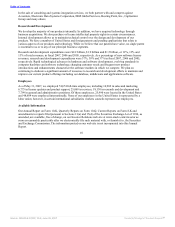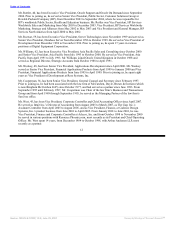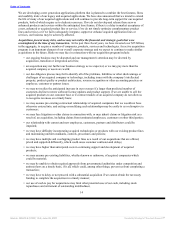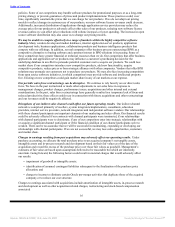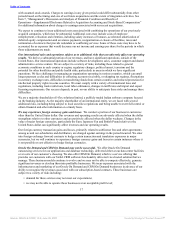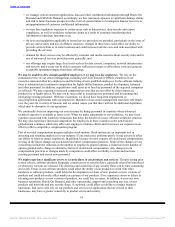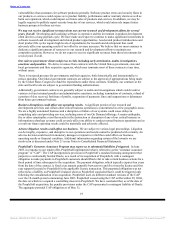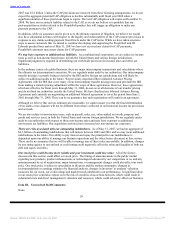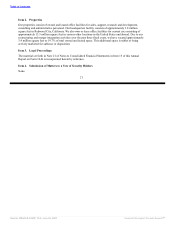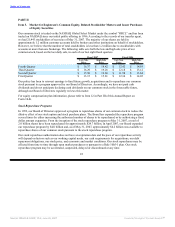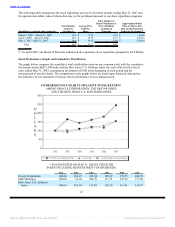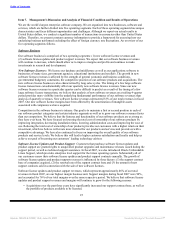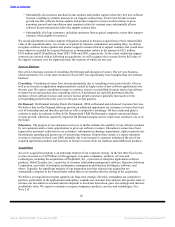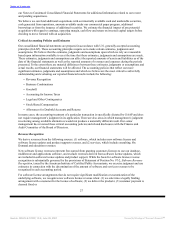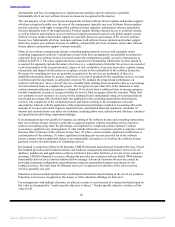Oracle 2006 Annual Report Download - page 23
Download and view the complete annual report
Please find page 23 of the 2006 Oracle annual report below. You can navigate through the pages in the report by either clicking on the pages listed below, or by using the keyword search tool below to find specific information within the annual report.
Table of Contents
vulnerabilities than customers for software products generally. Software product errors and security flaws in
our products or services could expose us to product liability, performance and/or warranty claims as well as
harm our reputation, which could impact our future sales of products and services. In addition, we may be
legally required to publicly report security breaches of our services, which could adversely impact future
business prospects for those services.
We may not receive significant revenues from our current research and development efforts for several
years, if at all. Developing and localizing software is expensive and the investment in product development
often involves a long payback cycle. We have made and expect to continue to make significant investments in
software research and development and related product opportunities. Accelerated product introductions and
short product life cycles require high levels of expenditures for research and development that could
adversely affect our operating results if not offset by revenue increases. We believe that we must continue to
dedicate a significant amount of resources to our research and development efforts to maintain our
competitive position. However, we do not expect to receive significant revenues from these investments for
several years if at all.
Our sales to government clients subject us to risks including early termination, audits, investigations,
sanctions and penalties. We derive revenues from contracts with the United States government, state and
local governments and their respective agencies, which may terminate most of these contracts at any time,
without cause.
There is increased pressure for governments and their agencies, both domestically and internationally, to
reduce spending. Our federal government contracts are subject to the approval of appropriations being made
by the United States Congress to fund the expenditures under these contracts. Similarly, our contracts at the
state and local levels are subject to government funding authorizations.
Additionally, government contracts are generally subject to audits and investigations which could result in
various civil and criminal penalties and administrative sanctions, including termination of contracts, refund of
a portion of fees received, forfeiture of profits, suspension of payments, fines and suspensions or debarment
from future government business.
Business disruptions could affect our operating results. A significant portion of our research and
development activities and certain other critical business operations is concentrated in a few geographic areas.
We are a highly automated business and a disruption or failure of our systems could cause delays in
completing sales and providing services, including some of our On Demand offerings. A major earthquake,
fire or other catastrophic event that results in the destruction or disruption of any of our critical business or
information technology systems could severely affect our ability to conduct normal business operations and as
a result our future operating results could be materially and adversely affected.
Adverse litigation results could affect our business. We are subject to various legal proceedings. Litigation
can be lengthy, expensive, and disruptive to our operations and results cannot be predicted with certainty. An
adverse decision could result in monetary damages or injunctive relief that could affect our business,
operating results or financial condition. Additional information regarding certain of the lawsuits we are
involved in is discussed under Note 21 in our Notes to Consolidated Financial Statements.
PeopleSoft’s Customer Assurance Program may expose us to substantial liabilities if triggered. In June
2003, in response to our tender offer, PeopleSoft implemented what it referred to as the “customer assurance
program” or “CAP”. The CAP incorporated a provision in PeopleSoft’s standard licensing arrangement that
purports to contractually burden Oracle, as a result of its acquisition of PeopleSoft, with a contingent
obligation to make payments to PeopleSoft customers should Oracle fail to take certain business actions for a
fixed period of time subsequent to the acquisition. The payment obligation, which typically expires four years
from the date of the contract, is fixed at an amount generally between two and five times the license and first
year support fees paid to PeopleSoft in the applicable license transaction. This purported obligation was not
reflected as a liability on PeopleSoft’s balance sheet as PeopleSoft concluded that it could be triggered only
following the consummation of an acquisition. PeopleSoft used six different standard versions of the CAP
over the 18-month period commencing June 2003. PeopleSoft ceased using the CAP on December 29, 2004,
the date on which we acquired a controlling interest in PeopleSoft. We have concluded that, as of the date of
the PeopleSoft acquisition, the penalty provisions under the CAP represented a contingent liability of Oracle.
The aggregate potential CAP obligation as of May 31,
19
Source: ORACLE CORP, 10-K, June 29, 2007 Powered by Morningstar® Document Research℠



